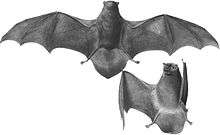Miniopterus
| Miniopterus | |
|---|---|
 | |
| Schreibers' bat, Miniopterus schreibersi | |
| Scientific classification | |
| Kingdom: | Animalia |
| Phylum: | Chordata |
| Class: | Mammalia |
| Order: | Chiroptera |
| Superfamily: | Vespertilionoidea |
| Family: | Miniopteridae Dobson, 1875 |
| Genus: | Miniopterus Bonaparte, 1837 |
| Species | |
|
See text | |
Miniopterus (bent-winged bat, long winged bat) is the only genus of bats in the family Miniopteridae. The genus had been placed in its own subfamily among vesper bats, Miniopterinae, but is now classified as its own family.
Morphology
Bent-winged bats are typically small (total length c. 10 cm, wingspans 30–35 cm, mass less than 20 g), with broad, short muzzles. The cranium is bulbous and taller than the snout, a feature shared with woolly bats and mouse-eared bats. This combination of features was likely present in the common ancestor of the vesper bats. They have two tiny, vestigial premolars between the upper canines and first large premolar. Unlike other bats, they lack a tendon-locking mechanism in their toes.
The common name of bent-winged bat refers to the group's ability to fold back their extra-long third finger when the wings are folded. This finger gives the bats long, narrow wings.[1]
Research applications
In 2017, evidence of deltaretroviruses was found in the genome of the Miniopteridae.[2] Deltaretroviruses only affect mammals, and this was the first evidence that they affected bat species.[2] The presence of the deltaretrovirus in multiple Miniopterid species suggests that the virus was present in the family before speciation 20 million years ago. [2] The evolutionary history of deltaretroviruses is important because they cause leukemia in humans.
Classification
Family Miniopteridae
- Genus Miniopterus - long-winged bats
- Miniopterus aelleni
- African long-fingered bat, Miniopterus africanus
- Little bent-wing bat, Miniopterus australis
- Miniopterus brachytragos
- Eger's long-fingered bat, Miniopterus egeri
- Miniopterus fossilis (fossil)
- Lesser long-fingered bat, Miniopterus fraterculus
- Eastern bent-wing bat, Miniopterus fuliginosus
- Southeast Asian long-fingered bat, Miniopterus fuscus
- Miniopterus gleni
- Miniopterus griffithsi
- Miniopterus griveaudi
- Greater long-fingered bat, Miniopterus inflatus
- Miniopterus macrocneme
- Maghrebian bent-wing bat, Miniopterus maghrebensis
- Western bent-winged bat, Miniopterus magnater
- Miniopterus mahafaliensis
- Miniopterus majori
- Manavi long-fingered bat, Miniopterus manavi
- Intermediate long-fingered bat, Miniopterus medius
- Least long-fingered bat, Miniopterus minor
- Miniopterus mossambicus[3]
- Natal long-fingered bat, Miniopterus natalensis
- Miniopterus newtoni
- Australasian bent-winged bat, Miniopterus oceanensis
- Philippine long-fingered bat, Minopterus paululus
- Miniopterus petersoni
- Small bent-winged bat, Miniopterus pusillus
- Loyalty bent-winged bat, Miniopterus robustior
- Common bent-wing bat, Miniopterus schreibersii
- Miniopterus shortridgei
- Miniopterus sororculus
- Great bent-winged bat, Miniopterus tristis
- Miniopterus zapfei (fossil)
Range
Bent-winged bats occur in southern Europe, across Africa and Madagascar, throughout Asia, and in Australia, Vanuatu and New Caledonia. One species, the common bent-wing bat, inhabits the whole of this range.[1] The group rapidly colonized much of this area in the last 15,000 years.
See also
References
- 1 2 "Bent-winged bats: wide ranges, very weird wings (vesper bats part III)". Retrieved 2015-05-07.
- 1 2 3 Farkašová, H., Hron, T., Pačes, J., Hulva, P., Benda, P., Gifford, R. J., & Elleder, D. (2017). Discovery of an endogenous Deltaretrovirus in the genome of long-fingered bats (Chiroptera: Miniopteridae). Proceedings of the National Academy of Sciences, 201621224.
- ↑ Monadjem, A.; Goodman, S.M.; Stanley, W.T.; Appleton, B. (2013). "A cryptic new species of Miniopterus from south-eastern Africa based on molecular and morphological characters". Zootaxa. 3746 (1): 123–142. doi:10.11646/zootaxa.3746.1.5.
- Goodman, S. M., K. E. Ryan, C. P. Maminirina, J. Fahr, L. Christidis, and B. Appleton. 2007. Specific status of populations on Madagascar referred to Miniopterus fraterculus (Chiroptera: Vespertillionidae), with description of a new species. Journal of Mammalogy, 88:1216-1229.
- Goodman, S.M., Maminirina, C.P., Weyeneth, N., Bradman, H.M., Christidis, L., Ruedi, M. & Appleton, B. 2009. The use of molecular and morphological characters to resolve the taxonomic identity of cryptic species: the case of Miniopterus manavi (Chiroptera: Miniopteridae). Zoologica Scripta 38: 339-363
- Mein, P. and Ginsburg, L. 2002. Sur l'âge relatif des différents karstiques miocènes de La Grive-Saint-Alban (Isère). Cahiers scientifiques, Muséum d'Histoire naturelle, Lyon 2:7–47.
- Miller-Butterworth, C., Murphy, W., O'Brien, S., Jacobs, D., Springer, M. and Teeling, E. 2007. A family matter: Conclusive resolution of the taxonomic position of the long-fingered bats, Miniopterus. Molecular Biology and Evolution 24(7):1553–1561.
- Simmons, N. B. 2005. Order Chiroptera. pp. 312–529 in Mammal Species of the World a Taxonomic and Geographic Reference. D. E. Wilson and D. M. Reeder eds. Johns Hopkins University Press, Baltimore.
- Furman, A., Öztunç, T. & Çoraman, E. 2010b. On the phylogeny of Miniopterus schreibersii schreibersii and Miniopterus schreibersii pallidus from Asia Minor in reference to other Miniopterustaxa (Chiroptera: Vespertilionidae). Acta Chiropterologica 12, 61-72.
| Wikimedia Commons has media related to Miniopterus. |